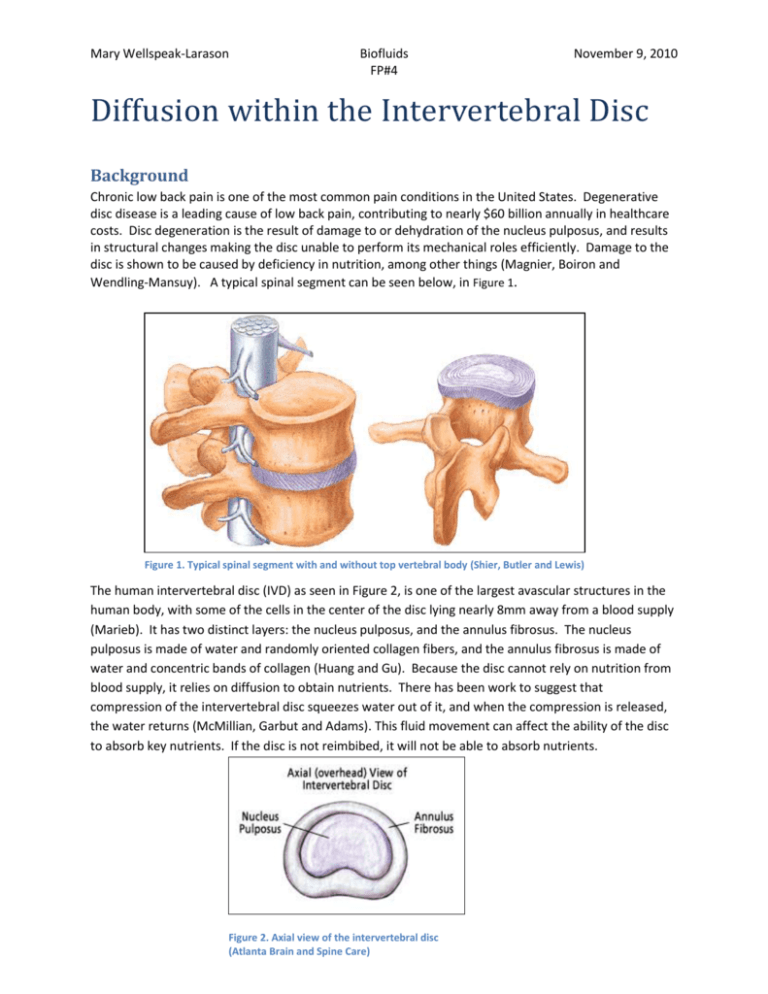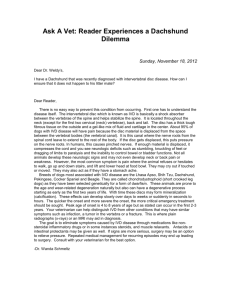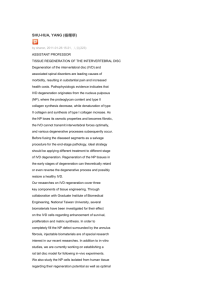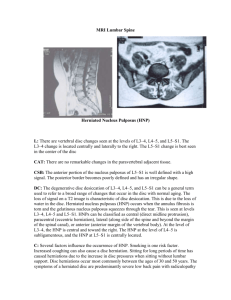Geometry and Mesh
advertisement

Mary Wellspeak-Larason Biofluids FP#4 November 9, 2010 Diffusion within the Intervertebral Disc Background Chronic low back pain is one of the most common pain conditions in the United States. Degenerative disc disease is a leading cause of low back pain, contributing to nearly $60 billion annually in healthcare costs. Disc degeneration is the result of damage to or dehydration of the nucleus pulposus, and results in structural changes making the disc unable to perform its mechanical roles efficiently. Damage to the disc is shown to be caused by deficiency in nutrition, among other things (Magnier, Boiron and Wendling-Mansuy). A typical spinal segment can be seen below, in Figure 1. Figure 1. Typical spinal segment with and without top vertebral body (Shier, Butler and Lewis) The human intervertebral disc (IVD) as seen in Figure 2, is one of the largest avascular structures in the human body, with some of the cells in the center of the disc lying nearly 8mm away from a blood supply (Marieb). It has two distinct layers: the nucleus pulposus, and the annulus fibrosus. The nucleus pulposus is made of water and randomly oriented collagen fibers, and the annulus fibrosus is made of water and concentric bands of collagen (Huang and Gu). Because the disc cannot rely on nutrition from blood supply, it relies on diffusion to obtain nutrients. There has been work to suggest that compression of the intervertebral disc squeezes water out of it, and when the compression is released, the water returns (McMillian, Garbut and Adams). This fluid movement can affect the ability of the disc to absorb key nutrients. If the disc is not reimbibed, it will not be able to absorb nutrients. Figure 2. Axial view of the intervertebral disc (Atlanta Brain and Spine Care) Mary Wellspeak-Larason Biofluids FP#4 November 9, 2010 Objectives The overall goal of this study is to develop a finite element model to predict the diffusion within the human IVD due to loading/unloading conditions. Specifically, we should be able to determine the rate of transport due to diffusion within the IVD. A 2-D axisymmetric model will be used for this simulation. Figure 1 below shows a simplified geometry from that of the actual intervertebral disc, and Figure 2 shows the axisymmetric geometry. This simulation will be done in two steps: 1. Structural analysis a. A transient structural FE model will be developed to evaluate the forces and strains acting on the IVD over a period of compression-relaxation, and to determine the maximum displacement of the IVD during the diurnal loading cycle 2. Diffusion a. A model will need to be implemented to examine the diffusion in and out of the disc under diurnal loading conditions Assumptions To simplify this model, several assumptions need to be made: 1. The IVD will be assumed to be cylindrical, allowing for 2D-axisymmetric modeling 2. There is no transport by convection for the model- All transport is assumed to be diffusive 3. Due to the simplified cylindrical model, we will use the average dimensions of the IVD as the dimensions of the modeled disc 4. The properties (density, viscosity) of the interstitial fluid remain constant 5. The annulus fibrosus will not be broken into individual layers Schematic 50.0mm NP-Nucleus Pulposus 39.0mm AF-Annulus Fibrosus 0.5mm NP AF 12.5mm Z Y X Figure 3. Schematic of IVD with dimensions Mary Wellspeak-Larason Biofluids FP#4 November 9, 2010 Figure 4. Geometry as modeled in Comsol As seen in Figure 3, the geometry in COMSOL consists of several cylinders with different dimensions. The actual geometry to be solved is shown in Figure 4. The nucleus pulposus is within the annulus fibrosus, and the bony vertebral endplate is on top. A force of 500N is applied to the top layer of the endplate to simulate the physiologic loading condition. Governing Equations Because we are modeling this as 2D-axisymmetric, the coordinate system for this problem will be cylindrical. The governing equations for fluid and mass transfer can be found in Chapter 7 (Datta and Rakesh, An Introduction to Modeling of Transport Processes: Applications to Biomedical Systems). The governing equations for strain-displacement is as follows: 𝜀𝑥𝑥 = 𝜀𝑥𝑦 = 𝜕𝑢𝑥 𝜕𝑥 1 𝜕𝑢𝑥 𝜕𝑢𝑦 ( + ) 2 𝜕𝑦 𝜕𝑧 𝜀𝑦𝑦 = 𝜀𝑥𝑧 = 𝜕𝑢𝑦 𝜕𝑦 1 𝜕𝑢𝑥 𝜕𝑢𝑧 ( + ) 2 𝜕𝑧 𝜕𝑧 𝜀𝑧𝑧 = 𝜕𝑢𝑧 𝜕𝑧 1 𝜕𝑢𝑦 𝜕𝑢𝑧 𝜀𝑦𝑧 = ( + ) 2 𝜕𝑧 𝜕𝑦 where ε is the strain and u is the displacement (Armenakas). These equations is used to solve for the displacement, given the strain. The strain is related to the force acting on the disc. The governing equation for mass transfer, assuming constant density and diffusivity, is as follows: 𝜕𝐶 𝜕𝐶 𝜕𝐶 𝜕𝐶 𝜕2𝐶 𝜕2𝐶 𝜕2𝐶 + (𝑣𝑥 + 𝑣𝑦 + 𝑣𝑧 ) = 𝐷 ( 2 + 2 + 2 ) 𝜕𝑡 𝜕𝑥 𝜕𝑦 𝜕𝑧 𝜕𝑥 𝜕𝑦 𝜕𝑧 where C is the concentration of water, and D is the diffusivity of the water (Datta and Rakesh). Mary Wellspeak-Larason Biofluids FP#4 November 9, 2010 Boundary Conditions The initial conditions will include: 1. The physiologic loading condition of 500N will be applied to the top surface of the IVD 2. The bottom surface of the IVD will be fixed in the z-direction (so the bottom surface will not move downwards under loading) 3. The initial concentration flux will be zero between the NP and the AF 4. Initial velocities at layers will be equal to zero 5. Diffusivity of interstitial fluid into the layers is 3.0x10-9 m2/s 6. Elastic modulus of the NP and AF are 1.5 MPa and 2.5MPa, respectively 7. Poisson's ratio for NP and AF are 0.17 and 0.33, respectively Material properties were found in the literature (Magnier, Boiron and Wendling-Mansuy) Loading Conditions The load on the disc models a diurnal cycle. During the day, the disc is loaded for 16 hours, and then the disc has no load at night for 8 hours. This loading condition is entered into Comsol as: T<3600s 3600s ≤ T < 57600 57600≤ T < 86400 Fz=0 N/m2 Fz=-500 N/m2 Fz=0 N/m2 Mary Wellspeak-Larason Biofluids FP#4 November 9, 2010 Simplified Solution COMSOL was unable to solve a simpler 2D axisymmetric model. When under the appropriate loading conditions, the model did not converge. So, a simple 3D model was examined. The following subsections outline the modeling procedure. 1st Simplified Model Assumptions 1. The IVD is one material i.e. the AF and NP are the same material 2. The material properties of the disc are that of the annulus fibrosus 3. The density of the disc remains constant Geometry and Mesh Due to the cylindrical shape of the model, a free mesh was used with 11300 elements. Figure 5. Geometry and Mesh Mary Wellspeak-Larason Biofluids FP#4 November 9, 2010 Preliminary Solution Figure 6. Surface Plot of Displacement and Deformation . .......Figure 7. Plot of Displacement [m] vs. Time [s] COMSOL predicts that the IVD displaces a maximum of 1.725e-3 m. For comparison, the literature states that the IVD displaces a maximum of 1.65e-3 m (Ferguson, Ito and Nolte). At T=60000s, the displacement rises above 0. This cannot be correct since there is a boundary that doesn’t allow the IVD to displacement in a positive z-direction. This is probably due to a convergence error. In the future, the mesh will be more refined to try to fix this error. (Armenakas) Mary Wellspeak-Larason Biofluids FP#4 2nd Simplified Model Assumptions 1. The IVD is only composed of the annulus fibrosus 2. The material properties of the disc are that of the annulus fibrosus 3. The density of the disc remains constant Geometry and Mesh A free mesh was used with 7982 elements. Figure 8. Geometry and mesh of 2nd simplified model Preliminary Solution Figure 9. Solution for 2nd simplified model November 9, 2010 Mary Wellspeak-Larason Biofluids FP#4 November 9, 2010 Figure 10. Plot of displacement [m] vs. time [s] This model predicts that the maximum displacement will be -1.785e-3 m. Again, this is comparable to that of the literature. Mary Wellspeak-Larason Biofluids FP#4 3rd Simplified Model Assumptions 1. The IVD is only composed of the nucleus pulposus 2. The material properties of the disc are that of the nucleus pulposus 3. The density of the disc remains constant Geometry and Mesh A free mesh was used with 11870 elements. Figure 11. Geometry and mesh of 3rd simplified model Preliminary Solution Figure 12. Solution to 3rd simplified model November 9, 2010 Mary Wellspeak-Larason Biofluids FP#4 November 9, 2010 Figure 13. Plot of Displacement [m] vs. Time [s] This model predicts that the maximum displacement is 3.29e-3 m. This is a lot larger than the literature states. The difference is most likely due to the model having the properties of the nucleus pulposus, which is much softer and more compressible than the model in the literature. Next Steps The simplified models will be combined to try to get the results closer to the literature. Mary Wellspeak-Larason Biofluids FP#4 Actual Model Geometry and Mesh The mesh is a free mesh and consists of 23955 elements. Figure14. Geometry and mesh of actual model Solution Figure 15. Solution of actual model November 9, 2010 Mary Wellspeak-Larason Biofluids FP#4 November 9, 2010 The actual model predicts takes on the properties of both the annulus fibrosus and nucleus pulposus, and the model combines the two in all aspects. The result is that for the deformation, the bony endplate deforms under the load and compresses more in the center than on the sides. This is not accurate since the endplate is a rigid bone. Next Steps This model needs a little more fine tuning to get accurate results. A mesh convergence study will be done, along with altering the boundary conditions and edge setting to get the geometry to work properly. Also, the diffusion model needs to be added into the structural mechanics model. References Armenakas, Anthony E. Advanced Mechanics of Materials and Applied Elasticity. Athens: CRC Press, 2005. Bogduk, Nikolai. Clinical Anatomy of the Lumbar Spine and Sacrum. Elsevier Churchill Livingstone, 2005. Datta, Ashim and Vineet Rakesh. An Introduction to Modeling of Transport Processes: Applications to Biomedical Systems. Cambridge: Cambridge University Press, 2009. Ferguson, Stephen J., Keita Ito and Lutz P. Nolte. "Fluid flow and convective tansport of solutes within the intervertebral disc." Journal of Biomechanics 37 (2004): 213-221. Huang, Chun-Yuh and Wei Yong Gu. "Effects of mechanical compression on metabolism and distribution of oxygen and lactate in intervertebral disc." Journal of Biomechanics 41 (2008): 1184-1196. Magnier, Carole, et al. "Nutrient distribution and metabolism in the intervertebral disc in the unloaded state: A parametric study." Journal of Biomechanics 42 (2009): 100-108. Marieb, Elaine N. Anatomy & Physiology. 3rd Ed. Benjamin Cummings, 2008. McMillian, D. W., G. Garbut and M. A. Adams. "Effect of sustained loading on the water content of intervertebral disc: implications for disc metabolism." Annals of Theumatic Diseases 55 (1996): 880-887. Shier, David, Jackie Butler and Ricki Lewis. Hole's Human Anatomy and Physiology. 7th Edition. Dubuque: Wm C. Brown, 1996.








